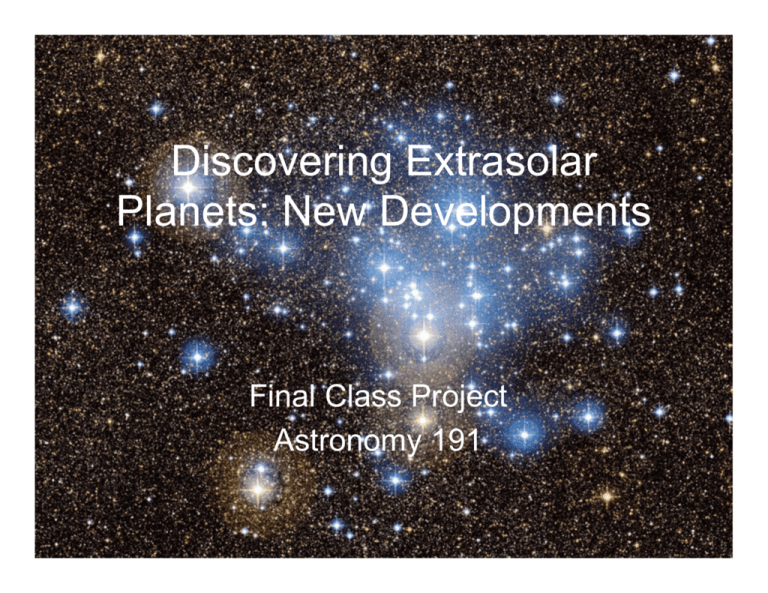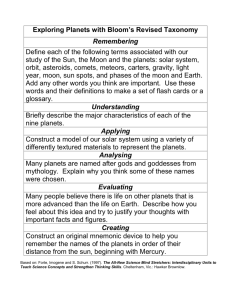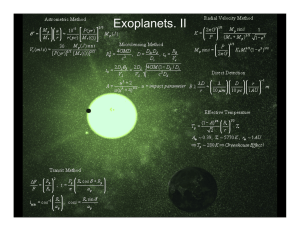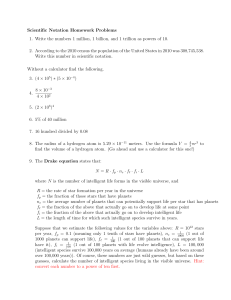Student 7
advertisement

Discovering Extrasolar Planets: New Developments Final Class Project Astronomy 191 Doppler Detection • How It Works! - Detects small changes in a star’s velocity when a star staggers under gravitational pull from a yet undetected exoplanet • HARPS (High Accuracy Radial Velocity Planet Searcher; a telescope) has helped to so far find 75 exoplanets over the past 5 years • Has different programs specifically to look for exoplanets around solar-like stars and M-dwarfs. Transit Detection • How It Works! – watches the dips in stars light. • When a planet is orbiting around a star there will be changes in the stars light when the planet is in front of or behind the star Astrometric Detection • How It Works! – observes the gravitational tugs of a host star to and away from earth. In other words, it looks for stellar wobbles • Method has been used for 50 years and is just now really being used as a viable source to detect extrasolar planets • Recently has discovered the lowest-mass star to host a planet; something other methods have not been able to do Direct Imaging Visible image of an extrasolar planet orbiting a star • How It Works! – method of just looking at stars using telescopes to detect planets orbiting; taking pictures instead of inferring from other methods • Visible photography can be used, but infrared detection is popularly used. Infrared is used to look for planets particularly around young, massive, nearby stars. Kinds of Planets: Excels and Limits Doppler Transit Astrometric Direct Imaging Great for detecting small planets (mass of a few times the earth) Great for detecting earthlike planets Great for detecting solar systems like our own Does not have to infer information like other methods Small planets in multi-planet systems Indirect Method Information Downfalls- inferred from parent planets Earthlike planets within the habitable region of their sun Indirect Method Direct Method Direct Method Information inferred from parent planets Takes years of observations to conclude May not be able to detect from ground viewings Works Cited Astronomy Picture of the Day. Web. 01 Dec. 2009. <http://antwrp.gsfc.nasa.gov/apod/astropix.html>. Beatty, Kelly. "Kepler Shows Its Promise." Sky & Telescope: The Essential Magazine of Astronomy. Sky Publishing, 7 Aug. 2009. Web. 11 Nov. 2009. <http://www.skyandtelescope.com/community/ skyblog/newsblog/52657352.html>. European Southern Observatory. "Towards Other Earths: 32 New Exoplanets Found." ScienceDaily 19 October 2009. 11 November 2009 <http://www.sciencedaily.com-/releases/ 2009/10/091019105304.htm>. Matson, John. "Out of this World Pictures: First Direct Photos of Exoplanets." Scientific American. Scientific American Inc., 13 Nov. 2009. Web. 11 Nov. 2009. <http://www.scientificamerican.com/ article.cfm?id=exoplanets-directimaging&page=2>. Naeye, Robert. "At Last, an Exoplanet by Astrometry." Sky & Telescope: The Essential Magazine of Astronomy.Sky Publishing, 29 May 2009. Web. 11 Nov. 2009. <http://www.skyandtelescope.com/community/skyblog/newsblog/46462532.html>. Strobel, Nick. Astronomy Notes. Astronomy Notes.com. 7 Apr. 2009. Web. 11 Nov. 2009. <http://www.astronomynotes.com/>. Wolf, Portia. "Extrasolar Planets." The Outer Planets. Laboratory for Atmospheric and Space Physics. Web. 11 Nov. 2009. <http://lasp.colorado.edu/education/outerplanets/credits.php>.











